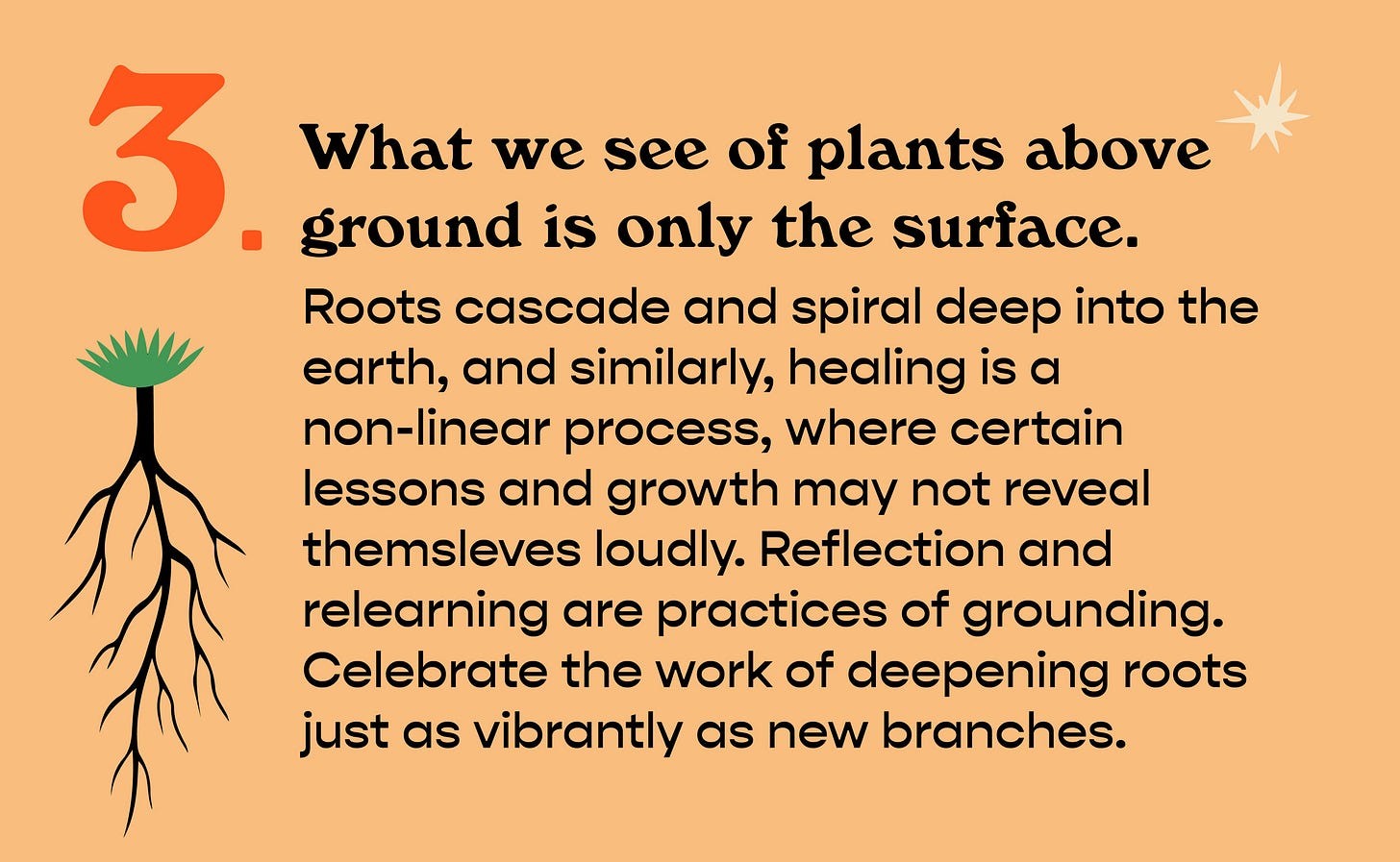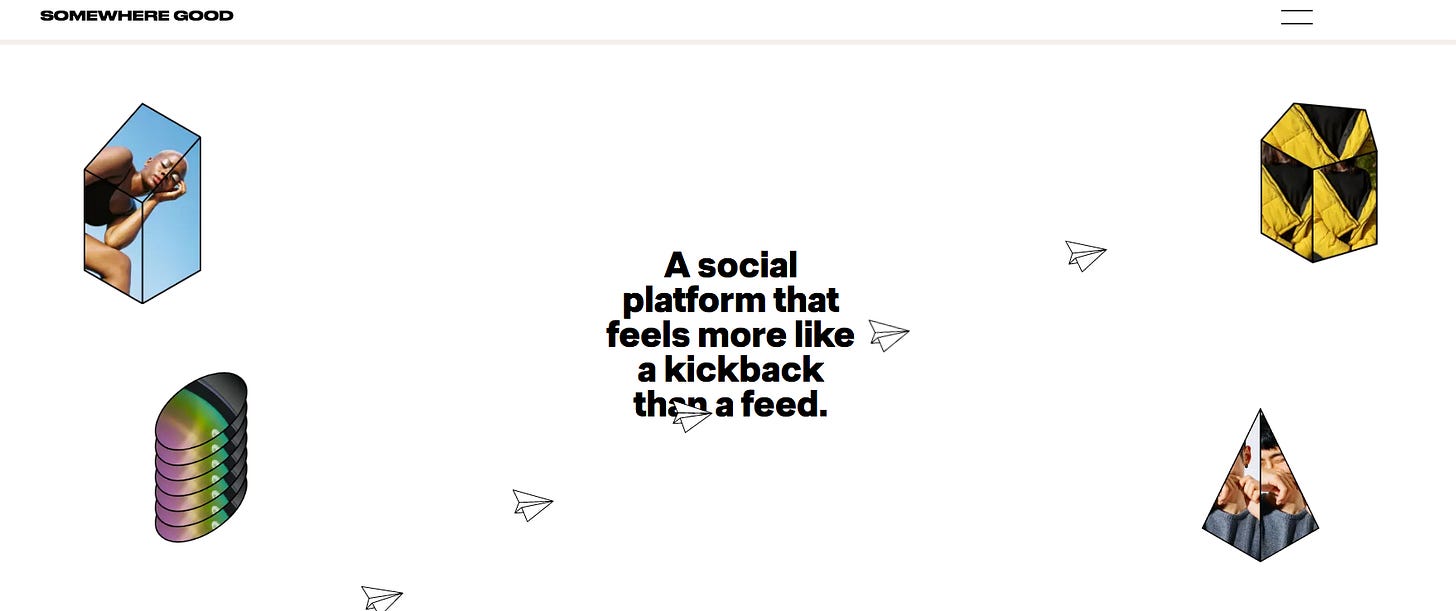🌿 Tend to Your Digital Gardens: Flowers, Weeds, and All
UX designer Annika Hansteen-Izora of Somewhere Good on why communal care is essential.
We’ve been talking a lot about Annika Hansteen-Izora’s Lessons Taught by Gardens at New_ Public. The metaphor is rich for community guidance and care, especially as we foresee the progression of new online platforms and consider the design opportunities for democracy-building. Hansteen-Izora is a queer, Black designer who is the creative director and UX designer for Somewhere Good, a family of brands that center people of color and include, soon-to-launch social platform of the same name; Ethel’s Club, an online wellness platform; and Form No Form, a 24-hour content channel.
She has become a visionary in rethinking the purpose and virtues of online platforms through seminars and workshops on tending to digital gardens. Hansteen-Izora is a passionate advocate, from intentionality and communal care, to design community ecosystems and creative systems. She writes, “I feel like when faced with large changes, societal or self, I tune into the lessons provided by elders and nature, lessons that are always available and are constantly revisited.”
In this way, gardens provide the metaphor for the constant maintenance and community care needed online. Hansteen-Izora translates the digital garden mission into the work she does in building Somewhere Good. The social media site is designed to feel like a welcoming playground, a place for imagination and where users can learn from each other. The landing page is a vibrant expression of blue sky opportunity stickered with fun visuals that bestow happiness. What is most interesting about the intended design of the space is that there will be no advertisements, no user profiles, no friending, no following, and no feed. We look forward to circling back on how these values manifest in the design after launch later this year. We are so excited and curious to experience it ourselves.
This week, we had the pleasure of speaking with Hansteen-Izora on how to become better digital gardeners. We received a sprinkling of their UX design thinking magic, and got schooled on Disability Justice tomes. The following conversation occurred by phone and has been edited for brevity and clarity.
Q&A
New_ Public: How did the idea of tending digital gardens come about?
Annika Hansteen-Izora: I'm a kid of the Internet. I grew up on Tumblr. I grew up on early IG. I've always understood the Internet as a space for possibility and learning. We're still so early in the days of social media and navigating what that looks like. I've noticed the ways that these platforms fall short for the needs of the people on these platforms. Instagram serves a lot of different purposes that it was never made for. It's become the mutual aid space, the mall, the community forum, the therapy couch. And it's failing at all of it. People are feeling unseen in so many different ways.
I love the idea that we can use gardening as a metaphor to better learn about online spaces. Gardens have an organized chaos. Gardens are communal. You have to have many hands supporting the work of maintaining a garden. Gardens are messy. You're going to have things die, rot, and tangled roots. Gardens embrace that messiness. The platforms that we currently have move away from messiness. There's a level of curation that becomes a flaw in the ability of people to actually connect to one another and to connect with knowledge. Digital gardens create this metaphor and opportunity to reimagine online spaces.
How do you teach communal care?
Communal care is a concept that was developed and named by Disability Justice advocates. It’s grounded in what it means to care for one another. Folks that are not embedded in white supremacy have been forced to survive off of communal care. Communal care is embedded in our practices in how we live and how we move through the world. I can feel tension when I'm not in a space that centers communal care.
We can bring communal care into our everyday interactions and spaces. We can start with questioning: What it would look like if I created support mechanisms that were connected to my people? Looking to the work of Disability Justice and queer and trans and Black activists who've embedded communal practices in their work. I think of:
Disability Visibility by Alice Wong
Care Work: Dreaming Disability Justice by Leah Lakshmi Piepzna-Samarasinha
Beyond Survival edited by Ejeris Dixon and Leah Lakshmi Piepzna-Samarasinha
We Do This 'Til We Free Us by Miriam Kaba
Emergent Strategy by Adrianne Maree Brown
The work of the Black Panthers. The entire organization was based off of communal practices.
How We Show Up by Mia Birdsong, looking at queer and trans history, and activism in the U.S.


How does a hyperdimensional network play into communal care?
There is this need to create linear narratives about ourselves, something that is clean, concise, and digestible. It is an effect of capitalism, but we are multimodal beings. We are the culmination of everything that has happened to us in the past and everything that we may become in the future. So there's this possibility and constant change. What does it look like if we can create an online space that is considering the ways that communal learning and communal connection can exist? How can we take on these subjects, while completely diverting from the ways that platforms have done it before?
That has led us to think about topics like: What does safety look like online? What does it look like to hold someone accountable in an online space? What does it look like if we take an account profile, and we redesign it with safety and communal connection at the root? That is something that's leading to a whole bunch of different products, rooting the design in principles of safety and community and care.
Safety is a huge concern online. Every community has an infiltrator or someone who's having a bad day and lashes out on other people. How are you designing for that?
What is the design experience when someone is reporting or flagging a user for harm or conflict or disagreement? If we think about Instagram, what I often see is that a harm is done and someone has to rally their followers to alert Instagram that harm has happened. We click the settings bar, and then there's the thing that pops up and asks ‘Do you want to report something?’ Then it's just gone into the Instagram ether, and you have no idea what is happening. Oftentimes people don't feel very affirmed by the process. Our Somewhere Good designer is thinking about the ways that we can design for this process to bring clarity, thoughtfulness, and intention.
The work that you do is at the intersection of culture, education, and history. What would you like to see more of in the world? Black Design Schools? BIPOC curriculum?
Yes, to both of the things that you name. Ultimately, I'm moved by platforms that are much slower than the timing and pacing of what we currently have offered to us. I'm excited by design that is slow web, calm web. An experience that allows people to better connect to themselves and more deeply connect to others. The best social media platforms are my group chats. They allow me to geek out over very specific subjects, or share events, resources, products, whatever, that are interesting. I get excited about platforms that are thinking about, what does it look like if we explore the Internet, as an archive, as a library, as a garden, as something that is rooted in building knowledge alongside others? Building knowledge means divorcing from the dominant white perspective, dismantling the supremacy of the eurocentrism in design, in who we see as the designers.
Is a flourishing digital space one that is made for all, or one made to protect smaller communities?
I once made a Twitter post about how I believe that the future of social media is moving away from these very large, anonymous audiences, and is instead moving towards smaller and intimate spaces. But then the assumption is that small equals a better experience when you can have an absolutely dreadful experience online, and it's only you and one other person or a small group of people. So it's not exactly the smallness or the size of the group that lends itself to the flourishing. The flourishing is rooted in ‘What is the intention of this group of people in this space?’ Everyone has seen dead Facebook groups, dead Reddit forums. There's no activity going on. People have stopped contributing to it. A lot of that is because there is no communal goal.

You’ve posed this question in a seminar and I would like to pose it back to you: What does a web rooted in care look like?
The Internet and social media end up reflecting the power structures of society at-large. I do not think a perfect space can ever exist on the Internet. In real life, there will always be conflict. There will always be harm. When I think about what care can look like on the web, there are possibilities for designing from that experience. Care means the ways that you are showing up for others, with intention, with thoughtfulness, with compassion. That can translate to a whole lot of different things on the Internet, depending on what you're trying to build. But just starting with, what does a calm experience look like on the Internet? What does a compassionate experience look like? I think these can end up translating and moving us towards a more caring Internet.
To learn more about Annika Hansteen-Izora and their work follow them on Twitter or on their creative website.
Do you have a tip or story idea that you would like to share with New_ Public? We truly value your feedback. Please send us an email to hello@newpublic.org.
Here with rakes and shovels,
The New_ Public team
Civic Signals is a partnership between the Center for Media Engagement at the University of Texas, Austin, and the National Conference on Citizenship, and was incubated by New America.






